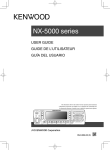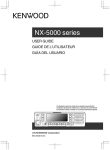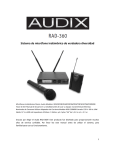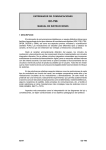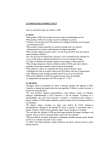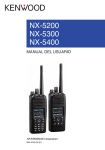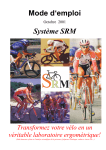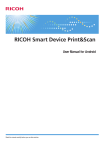Download KCH-20R - Kenwood
Transcript
KCH-20R USER MANUAL MODE D’EMPLOI MANUAL DEL USUARIO B5A‑0605-00 REMOTE CONTROL HEAD KCH-20R USER MANUAL • SDTM and microSDTM are trademarks of SD-3C, LLC in the United States. and/ or other countries. • The Bluetooth® word mark and logos are registered trademarks owned by Bluetooth SIG, Inc. and any use of such marks by JVC KENWOOD Corporation is under license. Other trademarks and trade names are those of their respective owners. Firmware Copyrights The title to and ownership of copyrights for firmware embedded in KENWOOD product memories are reserved for JVC KENWOOD Corporation. PRECAUTIONS • Do not disassemble or modify the unit for any reason. • Do not expose the unit to long periods of direct sunlight, nor place it close to heating appliances. • Do not place the unit in excessively dusty and/or humid areas, nor on unstable surfaces. • If you detect an abnormal odor or smoke coming from the unit, disconnect the power from the unit immediately. Contact your KENWOOD service center or dealer. • Do not attempt to configure the transceiver while driving; it is too dangerous. • Do not use options not specified by KENWOOD. • For passenger safety, install the unit securely using the supplied mounting bracket and screw set so the unit will not break loose in the event of a collision. • Always turn off the power before installing optional accessories. • When using the KCH-20R, refer to the “NOTICES TO THE USER” and “PRECAUTIONS” in the USER GUIDE of Mobile Transceiver of NX-5000 series. If the warnings ( ) are not observed, there may be the possibility to have any malfunction. In this case, press and hold the Power Switch for 5 seconds or more. If the malfunction persists, ask your dealer. SUPPLIED ACCESSORIES a Mounting bracket........................................................................................................... 1 b Mounting screw.............................................................................................................. 2 c Screw set (5 x 16 mm self-tapping screw x 4, Spring washer x 4, Flat washer x 4)..... 1 d Microphone cable holder................................................................................................ 1 e Pan head sems screw (M3 x 8 mm).............................................................................. 1 f PF name plates (the A, B and C name plate has been attached)................................. 1 f c e e d Microphone cable d b 2 a REPLACING THE PF NAME PLATE You can reconfigure the PF name plates at any time. 1 Remove the current PF name plate from the function key using a fine-tipped tool. 2 Punch out the PF name plate card, and insert the plate onto the relative function key. Name plate Squeeze and insert the plate INSTALLING THE microSD MEMORY CARD 1 Open the Cap. 2 Insert the microSD memory card. • Insert the microSD memory card with its terminal side facing the same side as the front of the panel. • Insert the microSD memory card until it clicks into place. • To remove the microSD memory card, push the card inwards once, then pull it out straight. microSD memory card Cap Note: ◆◆ microSD memory cards (Class 2 or higher) and microSDHC memory cards (Class 2 or higher) can be used. ◆◆ SDXC memory cards cannot be used. ◆◆ This transceiver is not guaranteed to operate with all microSD memory cards. (Operations are confirmed on memory cards for the following brands: SanDisk, TOSHIBA and Panasonic.) ◆◆ Use the microSD memory card within the allowable operating temperature. ◆◆ Do not remove the microSD memory card or turn off this transceiver while the microSD memory card is being accessed. ◆◆ The waterproof performance is not guaranteed if the microSD memory card slot cap is not fit into place. ◆◆ Make sure your hands are clean before opening the microSD memory card slot cap. Compensation Disclaimer Data stored on the microSD memory card may be altered or lost due to problems with this transceiver. We do not accept liability in respect of the data stored on your microSD memory card, failure to save the data properly, loss of data, and any direct or indirect damages. 3 ORIENTATION OPERATION PANEL a b c d e f g h i j k l m a[ ] (Power) switch Press to switch the transceiver ON or OFF. b[ ] / [ ] keys Press to activate its programmable function. c 4-way D-pad Press to activate its programmable function. d PF keys <with Name Plate> Press to activate its programmable function. e Auxiliary (orange) key Press to activate its programmable function. f Illumination sensor Sensor for Auto Dimmer Function. g TX Indicator Lights red while transmitting. h Busy / Status indicator Lights green while receiving. The indicator lights in different colors to indicate the current status of the transceiver. i Microphone jack Insert the microphone plug into this jack. j [ ] / [ ] / [ ] / [ ] / [ ] / [ ] keys Press to activate their programmable functions. k [ ] / [ ] keys Press to activate their programmable functions. l VOL (Volume) control Rotate clockwise to increase the volume level. Rotate counterclockwise to decrease the volume level. 4 m CH (Channel) control Rotate this control to activate its programmable function. (The default setting is Channel Select.) For details on programming functions to the keys on your transceiver, please contact your dealer or refer to the instruction manual available from the following URL. http://manual2.jvckenwood.com/en_contents/search/ DISPLAY Basic Frame Function Indicator Area Main Area Key Guide Area Message Frame Messenger Area Message Area Display Area Description Function Indicator Area Displays the various function indicators, signal strength indicator and clock. Main Area Displays the information of the transceiver such as Channel number and Zone number. Key Guide Area Displays the key functions for [ ], [ Messenger Area Displays the Caller ID/Name. Message Area Displays the message texts. 5 ], [ ], and [ ] keys. FUNCTION INDICATOR Indicator Description Displays the signal strength. The channel is using high transmit power. The channel is using medium transmit power. The channel is using low transmit power. In Digital mode (Digital Channel) In Analog mode (Analog Channel) In Digital mode (Mixed Channel) In Analog mode (Mixed Channel) The Bluetooth function is activated. Blinks in the process of turning on Bluetooth. Connected to Bluetooth device. The GPS position is determined. Blinks when the GPS is unable to determine the position. Non-priority Scan or Voting/Site Roaming is in progress. Blinks when the scan is paused. (green icon) Priority Scan is in progress. Blinks when the scan is paused. (red icon) Indicates Priority channel 1 or Priority Monitor ID 1. Indicates Priority channel 2 or Priority Monitor ID 2. Indicates Priority Monitor ID 3. Indicates Priority Monitor ID 4. The current channel is added to the scanning sequence. The current Zone is added to the Multi-Zone scanning sequence. The Scrambler function is activated. The Encryption function is activated. Blinks when receiving an encrypted carrier. The Encryption (AES) function is activated. Blinks when receiving an encrypted carrier. The Encryption (DES) function is activated. Blinks when receiving an encrypted carrier. 6 Indicator Description The Talk Around function is activated. The Monitor or Squelch Off is activated. The External Speaker is activated. The External Speaker (Internal + External) is activated. The Noise Reduction function is activated. Blinks when Noise Reduction is functioning. Blinks when an incoming call matches your Optional Signaling. A message is stored in memory. Blinks when a new message has arrived. The microSD memory card is recognized. The microSD memory card is not recognized. The VOX function is activated. The Site Lock function is activated. The Broadcast Call function is activated. The Surveillance function is activated. The selected group is programmed as telephone IDs. The Horn Alert function is activated. The Public Address function is activated. AUX A is activated. AUX B is activated. AUX C is activated. The Lone Worker function is activated. The Compander function is activated. The Operator Selectable Tone function is activated. Blinks during Auto Recording. The Key Lock function is activated. 7 TETE DE CONTRÔLE DEPORTEE KCH-20R MODE D’EMPLOI • SD™ et microSD™ sont des marques commerciales de SD-3C, LLC aux États-Unis et/ou dans d’autres pays. • La marque et les logos Bluetooth® sont des marques deposes appartenant à Bluetooth SIG, Inc. et toute utilisation de ces marques par JVC KENWOOD Corporation est sous licence. Les autres marques et noms commerciaux sont ceux de leurs propriétaires respectifs. Droits d’auteur du micrologiciel Le titre et la propriété des droits d’auteur pour le micrologiciel intégré dans la mémoire du produit KENWOOD sont réservés pour JVC KENWOOD Corporation. PRÉCAUTIONS • Ne démontez et ne modifiez sous aucun prétexte l’unité. • N’exposez pas l'unité aux rayons directs du soleil pendant de longues périodes et ne le placez pas près d’appareils chauffants. • Ne laissez pas l’appareil dans un endroit trop poussiéreux ni trop humide; ne le placez pas sur une surface instable. • Si une odeur anormale ou de la fumée est générée par l'unité, mettez immédiatement l’émetteur-récepteur hors tension et contactez votre revendeur KENWOOD. • Ne tentez pas de configurer l'unité tout en conduisant, car cela est trop dangeureux. • Ne pas utiliser les options non spécifiées par KENWOOD. • Pour la sécurité du passager, et pour éviter que l’émetteur-récepteur ne se détache en cas de collision, fixez solidement l'unité en utilisant le support de montage et l’ensemble des vis. • Veillez à toujours mettre hors tension avant d’installer des accessoires en option. • Lorsque vous utilisez le KCH-20R, reportez-vous à “AVIS AUX UTILISATEURS” et à “PRÉCAUTIONS” dans le “GUIDE DE L'UTILISATEUR” de l’émetteur-récepteur mobile ) ne sont pas respectés, il peut de la série NX-5000. Si les avertissement ( y avoir un risque de dysfonctionnement. Dans ce cas, appuyez sur le commutateur d’Alimentation et maintenez-le enfoncé pendant 5 secondes ou plus. Si le problème persiste, adressez-vous à votre revendeur. AVERTISSEMENT ACCESSOIRES FOURNIS a Support de montage...................................................................................................... 1 b Vis de montage.............................................................................................................. 2 c Ensemble de vis (Vis taraudeuse 5 x 16 mm x 4, Rondelle à ressort x 4, Rondelle ordinaire x 4).......... 1 d Dispositif de maintien du câble de microphone............................................................. 1 e Vis à tête bombée sems (M5 x 8 mm)........................................................................... 1 f Plaques signalétiques PF (les plaques signalétiques A, B et C sont déjà en place)..... 1 f c e e d Câbles de microphone d b F-2 a REMPLACEMENT DE LA PLAQUE SIGNALÉTIQUE PF Vous pouvez reconfigurer les plaques signalétiques n'importe quand. 1 Retirez la plaque signalétique PF actuelle de la touche de fonction en utilisant un outil à pointe fine. 2 Découpez la carte de la plaque signalétique PF, et insérez la plaque sur la touche de fonction correspondante. Plaque signalétique Faites pression et insérez la plaque INSTALLATION DE LA CARTE MÉMOIRE microSD 1 Ouvrez le cache. 2 Insérez la carte mémoire microSD. • Insérez la carte mémoire microSD avec le côté terminal orienté du même côté que l’avant du panneau. • Insérez la carte mémoire microSD jusqu’à ce qu’un clic se fasse entendre montrant que la carte est en place. • Pour retirer la carte mémoire microSD, poussez-la vers l’intérieur une fois, puis retirez-la sans la plier. carte mémoire microSD Cache Remarque: ◆◆ Les cartes mémoire SDXC ne peuvent pas être utilisées. ◆◆ Le fonctionnement de cet émetteur-récepteur n’est pas garanti avec toutes les cartes mémoire microSD. ◆◆ (Le fonctionnement est garanti sur les cartes mémoire pour les marques suivantes : SanDisk, TOSHIBA et Panasonic.) ◆◆ Utilisez la carte mémoire microSD dans la température de fonctionnement recommandée. ◆◆ Ne retirez pas la carte mémoire microSD ou n’éteignez pas cet émetteur-récepteur pendant que la carte mémoire microSD est en cours d’exécution. ◆◆ L’efficacité de l’étanchéité n’est pas garantie si le volet du logement de la carte mémoire microSD n’est pas en place. ◆◆ Assurez-vous d’avoir les mains propres avant d’ouvrir le volet du logement de la carte mémoire microSD. Avis de non-responsabilité de compensation Les données stockées sur la carte mémoire microSD peuvent être modifiées ou perdues à cause de problèmes avec cet émetteurrécepteur. Nous n’acceptons aucune responsabilité en ce qui concerne les données stockées sur votre carte mémoire microSD, l’échec de la sauvegarde correcte des données, la perte des données et de tout dommage direct ou indirect. F-3 ORIENTATION PANNEAU DE COMMANDE a b c d e f g h i j k l m a Commutateur [ ] (d’alimentation) Appuyez pour mettre l’émetteur-récepteur sous tension ou hors tension. b Touches [ ] / [ ] Appuyez sur la touche pour activer leurs fonctions programmables. c 4-voies D-pad Appuyez sur la touche pour activer leurs fonctions programmables. d Touches PF <Avec les plaques signalétiques> Appuyez sur la touche pour activer leurs fonctions programmables. e Touche auxiliaire (orange) Appuyez sur la touche pour activer leurs fonctions programmables. f Capteur d’éclairage Capteur pour fonction Variateur automatique. g Indicateur TX S’allume en rouge lors de la transmission. h Indicator d’occupé/ état S’allume en vert lors de la réception. Le indicateur s’allume avec des couleurs différentes pour indiquer l’état actuel de l’émetteur-récepteur. i Prise microphone Insérez la fiche du microphone dans cette prise. j Touches [ ] / [ ] / [ ] / [ ] / [ ] / [ ] Appuyez sur la touche pour activer leurs fonctions programmables. k Touches [ ] / [ ] Appuyez sur la touche pour activer leurs fonctions programmables. l Commande VOL (volume) Tournez la commande dans le sens des aiguilles d'une montre pour augmenter le niveau de volume. Tournez la commande dans le sens contraire des aiguilles d'une montre pour diminuer le niveau de volume. F-4 m Commande CH (canal) Tournez cette commande pour activer sa fonction programmable. (Leréglage par défaut est Sélection du canal.) Pour plus de détails sur les fonctions de programmation des touches de votre émetteurtransmetteur, veuillez contacter votre revendeur ou consultez le mode d’emploi disponible à l’adresse URL suivante. http://manual2.jvckenwood.com/en_contents/search/ AFFICHEUR Cadre de base Zone d’affichage des icons de fonctions Zone principale Zone de guide des touches Cadre de message Zone de messenger Zone de messages Zone d’affichage Zone d’indicateur de fonction Zone principale Description Affiche les diverses indicateurs de fonction, le témoin de puissance du signal et l’heure. Affiche les informations de l’émetteur-récepteur comme le nombre Canal et le nombre Zone. Zone de guide des touches Affiche les fonctions des touches pour [ ], [ Zone de messenger Afficher l'identification de l'appelant / nom . Zone de messages Afficher les textes de message. F-5 ], [ ] et [ ]. INDICATEUR DE FONCTION Indicateur Description Affiche la force du signal. Le canal utilise une énergie de transmission élevée. Le canal utilise une énergie de transmission moyenne. Le canal utilise une énergie de transmission faible. En mode numérique (Canal numérique) En mode analogique (Canal analogique) En mode numérique (Canal mixte) En mode analogique (Canal mixte) La fonction Bluetooth est activée. Clignote dans le processus d’activation du Bluetooth. Connecté à un dispositif Bluetooth. La position GPS est déterminée. Clignote lorsque le GPS est incapable de déterminer la position. Balayage non prioritaire ou Vote / Site Roaming est en cours. Clignote lorsque le balayage s’arrête momentanément. (indicateur vert) Balayage prioritaire est en cours. Clignote lorsque le balayage s’arrête momentanément. (indicateur rouge) Indique le canal prioritaire 1 ou l’ID de l’écran prioritaire 1. Indique le canal prioritaire 2 ou l’ID de l’écran prioritaire 2. Indique l’ID de l’écran prioritaire 3. Indique l’ID de l’écran prioritaire 4. Le canal en cours est ajouté à la séquence de balayage. La zone courante est ajoutée à la séquence de balayage multi-zone. La fonction Brouilleur est activée. La fonction Encodage est activée. Clignote lors de la réception d’un transporteur crypté. La fonction Encodage (AES) est activée. Clignote lors de la réception d’un transporteur crypté. La fonction Encodage (DES) est activée. Clignote lors de la réception d’un transporteur crypté. La fonction Talk Around est activée F-6 Indicateur Description La fonction Surveillance ou Silencieux désactivé est activée. Haut-parleur externe est activé. Le haut-parleur externe (interne + externe) est activé. La fonction Réduction du bruit est activée. Clignote lorsque Réduction du bruit fonctionne. Clignote lorsqu’un appel entrant correspond à vos Signal facultatif. Un message est enregistré dans la mémoire. Clignote lorsqu’on reçoit un nouveau message. La carte mémoire microSD est reconnue. La carte mémoire microSD n’est pas reconnue. La fonction VOX est activée. La fonction Verrouillage site est activée. La fonction Appel de diffusion est activée. La fonction Surveillance est activée. Le groupe sélectionné est programmé en tant qu’ID de téléphone. La fonction Avertissement par klaxon est activée. La fonction Sonorisation est activée. AUX A est activé. AUX B est activé. AUX C est activé. La fonction Travailleur seul est activée. La fonction Compander est activée. La fonction Tonalité sélectionnable par l'opérateur est activée. Clignote pendant Enregistrement automatique. La fonction Verrouillage des touches est activée. F-7 CABEZAL CONTROL REMOTO KCH-20R MANUAL DEL USUARIO • SD™ y microSD™ son marcas comerciales de SD-3C, LLC en los Estados Unidos y/o en otros países. • La marca denominativa y los logos de Bluetooth® son marcas comerciales registradas propiedad de Bluetooth SIG, Inc. y cualquier uso de dichas marcas por JVC KENWOOD Corporation se encuentra bajo licencia. Otras marcas y nombres comerciales pertenecen a sus respectivos dueños. Derechos de propiedad intelectual del firmware La titularidad y propiedad de los derechos de propiedad intelectual del firmware integrado en las memorias de los productos KENWOOD están reservados para JVC KENWOOD Corporation. PRECAUCIONES • No desmonte ni modifique la unidad bajo ningún concepto. • No exponga el transceptor a la luz directa del sol durante periodos de tiempo prolongados, ni lo coloque cerca de calefactores. • No coloque la unidad en lugares excesivamente húmedos o polvorientos, o sobre superficies inestables. • Si detecta un olor anormal o humo procedente del transceptor, desconecte inmediatamente la alimentación y póngase en contacto con su proveedor KENWOOD. • No intente configurar la unidad mientras conduce, ya que resulta demasiado peligroso. • No utilice opciones no especificadas por KENWOOD. • Para la seguridad de los pasajeros, instale la unidad de forma segura utilizando el soporte de montaje y el juego de tornillos de forma que el transceptor no se suelte en caso de colisión. • Siempre apague la corriente antes de instalar los accesorios opcionales. • Al usar KCH-20R, consulte “AVISOS AL USUARIO” y “PRECAUCIONES” en la GUÍA DEL USUARIO del transceptor móvil de la serie NX-5000. Si no respeta las ), podría producirse un funcionamiento incorrecto. En dicho advertencias ( caso, mantenga pulsado el interruptor de alimentación durante 5 segundos o más. Si el problema persiste, póngase en contacto con su distribuidor. ADVERTENCIA ACCESORIOS SUMINISTRADOS a Soporte de montaje....................................................................................................... 1 b Tornillo de montaje......................................................................................................... 2 c Juego de tornillos (Tornillo autorroscante de 5 x 16 mm x 4, Arandela de resorte x 4, Arandela plana x 4)............................................................... 1 d Soporte del cable del micrófono.................................................................................... 1 e Tornillo Sems de cabeza plana (M3 x 8 mm)................................................................. 1 f Placas de identificación PF (las placas de identificación A, B y C han sido adjuntadas)..... 1 f c e e d Cable de micrófono d b E-2 a REEMPLAZO DE LA PLACA DE IDENTIFICACIÓN PF Las placas de identificación PF se pueden volver a configurar en cualquier momento. 1 Utilizando una herramienta de punta fina, retire la actual placa de identificación PF de la tecla de función. 2 Extraiga la tarjeta de la placa de identificación PF, e inserte la placa en la respectiva tecla de función. Placa de identificación Apriete e inserte la placa INSTALACIÓN DE LA TARJETA DE MEMORIA microSD 1 Abra la tapa. 2 Inserte la tarjeta de memoria microSD. • Inserte la tarjeta de memoria microSD con el lado de su terminal orientado hacia el mismo lado que la parte delantera del panel. • Inserte la tarjeta de memoria microSD hasta que haga clic en su lugar. • Para extraer la tarjeta de memoria microSD, presione la tarjeta hacia dentro una vez y luego extráigala derecha hacia fuera. Tarjeta de memoria microSD Tapa Nota: ◆◆ Se pueden utilizar tarjetas de memoria microSD (clase 2 o superior) y tarjetas de memoria microSDHC (clase 2 o superior). ◆◆ No se pueden utilizar tarjetas de memoria SDXC. ◆◆ No se garantiza que este transceptor funcione con todas las tarjetas de memoria microSD. ◆◆ (Se confirman las operaciones en tarjetas de memoria para las siguientes marcas: SanDisk, TOSHIBA y Panasonic). ◆◆ Utilice la tarjeta de memoria microSD dentro del rango de temperature de funcionamiento. ◆◆ No extraiga la tarjeta de memoria microSD ni apague este transceptor mientras se está accediendo a la tarjeta memoria microSD. ◆◆ No se garantiza la impermeabilidad si la tapa de la ranura de la tarjeta de memoria microSD no está ajustada en su lugar. ◆◆ Asegúrese de que sus manos estén limpias antes de abrir la tapa de la ranura de la tarjeta de memoria microSD. Descargo de responsabilidad de compensación Los datos guardados en la tarjeta de memoria microSD se pueden modificar o perder debido a problemas con este transceptor. No aceptamos ninguna responsabilidad en relación con los datos almacenados en su tarjeta de memoria microSD, fallos al guardar los datos correctamente, pérdida de datos, y cualquier daño directo o indirecto.. E-3 ORIENTACIÓN PANEL DE OPERACIONES a b c d e f g h i j k l m a Interruptor [ ] (alimentación) Pulse para activar o desactivar el transceptor. b Teclas [ ] / [ ] Pulse para activar sus funciones programables. c D-pad de 4 vías Pulse para activar sus funciones programables. d Teclas PF <con las placas de identificación> Pulse para activar sus funciones programables. e Tecla auxiliar (naranja) Pulse para activar o desactivar el transceptor. f Sensor de iluminación Sensor para la función Atenuador automático. g Indicador TX Se ilumina en color rojo mientras transmite. h Indicador de ocupado/ estado Se ilumina en color verde mientras recibe. El indicador se ilumina en colores diferentes para indicar el estado actual del transceptor. i Conector de micrófono Inserte la clavija del micrófono en este conector. j [ ] / [ ] / [ ] / [ ] / [ ] / [ ] keys Pulse para activar sus funciones programables. k Teclas [ ] / [ ] Pulse para activar sus funciones programables. l Control VOL (Volumen) Gire en sentido horario para aumentar el nivel de volumen. Gire en sentido antihorario para disminuir el nivel de volumen. E-4 m Control CH (Canal) Gire este control para activar su función programable. (El ajuste predeterminado es Selección de canal.) Para mas informacion acerca de la programacion de las funciones de teclas en su transceptor, pongase en contacto con su distribuidor o consulte el manual de instrucciones disponible en el siguiente URL. http://manual2.jvckenwood.com/en_contents/search/ PANTALLA Marco básico Área del indicador de la función Área principal Área de guía de tecla Marco mensaje Área de mensajero Área de mensajes Área de visualización Descripción Area del indicador de la funcion Muestra los distintos indicadores de funcion, el indicador de intensidad de la senal y el reloj. Área principal Muestra la información del transceptor como, por ejemplo, el número Canal y el número Zona. Área de guía de tecla Visualiza las funciones de las teclas [ ], [ Área mensajero Muestra el identificador de llamadas / Nombre. Área de mensajes Muestra los textos de mensaje. E-5 ], [ ] y [ ]. INDICADOR DE LA FUNCIÓN Indicador Descripción Muestra la intensidad de la señal. El canal utiliza transmisión de alta potencia. El canal utiliza transmisión de media potencia. El canal utiliza transmisión de baja potencia. En el modo digital (Canal digital) En el modo analógico (Canal analógico) En el modo digital (Canal mixto) En el modo analógico (Canal mixto) La función Bluetooth está activada. Parpadea durante el proceso de activación de Bluetooth. Conectado a un dispositivo Bluetooth. Se define la posición GPS. Parpadea cuando el sistema GPS no puede determinar la posición. Exploración no prioritario o Votación/ Roaming Sitio está en curso. Parpadea cuando la exploración está en pausa. (indicador verde) Exploración prioritaria está en curso. Parpadea cuando la exploración está en pausa. (indicador rojo) Indica prioridad canal 1 o prioridad Monitor ID 1. Indica prioridad canal 2 o prioridad Monitor ID 2. Indica prioridad Monitor ID 3. Indica prioridad Monitor ID 4. El canal actual se añade a la secuencia de escaneado. La zona actual se añade a la secuencia de escaneado Multi-Zone. La función Mezclador está activada. La función Cifrado está activada. Parpadea al recibir un portador cifrado. La función Cifrado (AES) está activada. Parpadea al recibir un portador cifrado La función Cifrado (DES) está activada. Parpadea al recibir un portador cifrado. La función Talk Around está activada. E-6 Indicador Descripción La función Monitor o Desactivar Silenciamiento está activada. El altavoz externo está activado. El altavoz externo (Interno + Externo) está activado. La función Reducción de ruido está activada. Parpadea cuando Reducción de ruido está funcionando. Parpadea cuando una llamada entrante coincide con Señal opcional. Hay un mensaje almacenado en la memoria. Parpadea cuando se recibe un mensaje nuevo. La tarjeta de memoria microSD es reconocida. La tarjeta de memoria microSD no es reconocida. La función VOX está activada. La función Bloqueo de sitio está activada. La función Llamada de Difusión está activada. La función Vigilancia está activada. El grupo seleccionado se programa como ID telefónica. La función Bocina de alerta está activada. La función Megafonía está activada. AUX A está activado. AUX B está activado. AUX C está activado. La función Trabajador solo está activada. La función Compansor está activada. La función Tono seleccionable por operador está activada. Parpadea durante Grabación automática. La función Bloqueo de las teclas está activada. E-7 INFORMATION ON SOFTWARE LICENSE This unit uses a software based on the license below. *zlib LICENSE Copyright (C) 1995-2013 Jean-loup Gailly and Mark Adler This software is provided 'as-is', without any express or implied warranty. In no event will the authors be held liable for any damages arising from the use of this software. Permission is granted to anyone to use this software for any purpose, including commercial applications, and to alter it and redistribute it freely, subject to the following restrictions: 1. The origin of this software must not be misrepresented; you must not claim that you wrote the original software. If you use this software in a product, an acknowledgment in the product documentation would be appreciated but is not required. 2. Altered source versions must be plainly marked as such, and must not be misrepresented as being the original software. 3. This notice may not be removed or altered from any source distribution. Jean-loup Gailly ( [email protected]) Mark Adler ([email protected]) *Libpng LICENSE This copy of the libpng notices is provided for your convenience. In case of any discrepancy between this copy and the notices in the file png.h that is included in the libpng distribution, the latter shall prevail. COPYRIGHT NOTICE, DISCLAIMER, and LICENSE: If you modify libpng you may insert additional notices immediately following this sentence. This code is released under the libpng license. libpng versions 1.2.6, August 15, 2004, through 1.6.8, December 19, 2013, are Copyright (c) 2004, 2006-2013 Glenn Randers-Pehrson, and are distributed according to the same disclaimer and license as libpng-1.2.5 with the following individual added to the list of Contributing Authors Cosmin Truta libpng versions 1.0.7, July 1, 2000, through 1.2.5 - October 3, 2002, are Copyright (c) 2000-2002 Glenn Randers-Pehrson, and are distributed according to the same disclaimer and license as libpng-1.0.6 with the following individuals added to the list of Contributing Authors Simon-Pierre Cadieux Eric S. Raymond Gilles Vollant and with the following additions to the disclaimer: There is no warranty against interference with your enjoyment of the library or against infringement. There is no warranty that our efforts or the library will fulfill any of your particular purposes or needs. This library is provided with all faults, and the entire risk of satisfactory quality, performance, accuracy, and effort is with the user. libpng versions 0.97, January 1998, through 1.0.6, March 20, 2000, are Copyright (c) 1998, 1999 Glenn Randers-Pehrson, and are distributed according to the same disclaimer and license as libpng-0.96, with the following individuals added to the list of Contributing Authors: Tom Lane Glenn Randers-Pehrson Willem van Schaik libpng versions 0.89, June 1996, through 0.96, May 1997, are Copyright (c) 1996, 1997 Andreas Dilger Distributed according to the same disclaimer and license as libpng-0.88, with the following individuals added to the list of Contributing Authors: John Bowler Kevin Bracey Sam Bushell Magnus Holmgren Greg Roelofs Tom Tanner 1 libpng versions 0.5, May 1995, through 0.88, January 1996, are Copyright (c) 1995, 1996 Guy Eric Schalnat, Group 42, Inc. For the purposes of this copyright and license, "Contributing Authors" is defined as the following set of individuals: Andreas Dilger Dave Martindale Guy Eric Schalnat Paul Schmidt Tim Wegner The PNG Reference Library is supplied "AS IS". The Contributing Authors and Group 42, Inc. disclaim all warranties, expressed or implied, including, without limitation, the warranties of merchantability and of fitness for any purpose. The Contributing Authors and Group 42, Inc. assume no liability for direct, indirect, incidental, special, exemplary, or consequential damages, which may result from the use of the PNG Reference Library, even if advised of the possibility of such damage. Permission is hereby granted to use, copy, modify, and distribute this source code, or portions hereof, for any purpose, without fee, subject to the following restrictions: 1. The origin of this source code must not be misrepresented. 2. Altered versions must be plainly marked as such and must not be misrepresented as being the original source. 3. This Copyright notice may not be removed or altered from any source or altered source distribution. The Contributing Authors and Group 42, Inc. specifically permit, without fee, and encourage the use of this source code as a component to supporting the PNG file format in commercial products. If you use this source code in a product, acknowledgment is not required but would be appreciated. A "png_get_copyright" function is available, for convenient use in "about" boxes and the like: printf("%s",png_get_copyright(NULL)); Also, the PNG logo (in PNG format, of course) is supplied in the files "pngbar.png" and "pngbar.jpg (88x31) and "pngnow.png" (98x31). Libpng is OSI Certified Open Source Software. OSI Certified Open Source is a certification mark of the Open Source Initiative. Glenn Randers-Pehrson glennrp at users.sourceforge.net December 19, 2013 *Md5 Copyright (C) 1999, 2000, 2002 Aladdin Enterprises. All rights reserved. This software is provided 'as-is', without any express or implied warranty. In no event will the authors be held liable for any damages rising from the use of this software. Permission is granted to anyone to use this software for any purpose, including commercial applications, and to alter it and redistribute it freely, subject to the following restrictions: 1. The origin of this software must not be misrepresented; you must not claim that you wrote the original software. If you use this software in a product, an acknowledgment in the product documentation would be appreciated but is not required. 2. Altered source versions must be plainly marked as such, and must not be misrepresented as being the original software. 3. This notice may not be removed or altered from any source distribution. L. Peter Deutsch [email protected] 2 © 2015

























